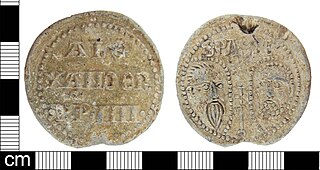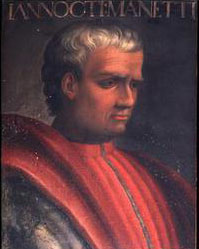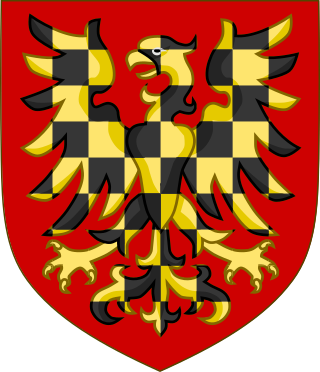Related Research Articles

Pope Alexander IV was head of the Catholic Church and ruler of the Papal States from 12 December 1254 to his death.

Pope Innocent III, born Lotario dei Conti di Segni, was the head of the Catholic Church and ruler of the Papal States from 8 January 1198 until his death on 16 July 1216.

Pope Innocent XIII, born as Michelangelo dei Conti, was head of the Catholic Church and ruler of the Papal States from 8 May 1721 to his death in March 1724. He is the most recent pope to date to take the pontifical name of "Innocent" upon his election.
Conti is an Italian surname.

A Treatise on the Astrolabe is a medieval instruction manual on the astrolabe by Geoffrey Chaucer. It was completed in 1391. It describes both the form and the proper use of the instrument, and stands out as a prose technical work from a writer better known for poetry, written in English rather than the more typical Latin.
Geoffrey of Vinsauf is a representative of the early medieval grammarian movement, termed preceptive grammar for its interest in teaching the ars poetica.

Giannozzo Manetti (1396–1459) was an Italian politician and diplomat from Florence, who was also a humanist scholar of the early Italian Renaissance and an anti-Semitic polemicist.

Giovanni Francesco Pico della Mirandola (1470–1533) was an Italian nobleman and philosopher, the nephew of Giovanni Pico della Mirandola. His name is typically truncated as Gianfrancesco Pico della Mirandola.
Henry of Segusio, usually called Hostiensis, was an Italian canonist of the thirteenth century, born at Susa (Segusio), in the ancient Diocese of Turin. He died at Lyon.

The Suburbicarian Diocese of Velletri–Segni is one of the Latin suburbicarian dioceses, Catholic dioceses in Italy close to Rome with a special status and a cardinal bishop, the bishop of Velletri–Segni. Historically, the see of Velletri was combined with the see of Ostia from 1060 to 1914.

Heinrich Eggestein is considered, along with Johannes Mentelin, to be the earliest book printer in Strasbourg and therefore one of the earliest anywhere in Europe outside Mainz.

The Diocese of Anagni-Alatri is a Latin Church ecclesiastical territory or diocese of the Catholic Church in Lazio, Italy. It has existed in its current form since 1986. In that year the Diocese of Alatri was united to the historical Diocese of Anagni. The diocese is immediately exempt to the Holy See.

The 1198 papal election was convoked after the death of Pope Celestine III; it ended with the election of Cardinal Lotario dei Conti di Segni, who took the name Innocent III. In this election for the first time the new pope was elected per scrutinium.
Contemptus mundi, the "contempt of the world" and worldly concerns, is a theme in the intellectual life of both Classical Antiquity and of Christianity, both in its mystical vein and its ambivalence towards secular life, that figures largely in the Western world's history of ideas. In inculcating a turn of mind that would lead to a state of serenity untrammeled by distracting material appetites and feverish emotional connections, which the Greek philosophers called ataraxia, it drew upon the assumptions of Stoicism and a neoplatonism that was distrustful of deceptive and spurious appearances. In the familiar rhetorical polarity in Hellenic philosophy between the active and the contemplative life, which Christians, who expressly rejected "the World, the Flesh and the Devil", might exemplify as the way of Martha and the way of Mary, contemptus mundi assumed that only the contemplative life was of lasting value and the world an empty shell, a vanity.
The 1254 papal election took place following the death of Pope Innocent IV and ended with the choice of Raynaldus de' Conti, who took the name Pope Alexander IV. The election was held in Naples, in the former palazzo of Pietro della Vigna, and required only one day.

The counts of Segni were an important noble family of medieval and early modern Italy originating in Segni, Lazio. Many members of the family acted as military commanders or ecclesiastical dignitaries, including many cardinals and four popes.
Opizzo Fieschi, also known as Opizo or Opiso dei' Fieschi, was a 13th-century Italian cleric from the powerful Genovese Fieschi family. Following his uncle Sinibaldo's election as Pope Innocent IV, Opizzo was appointed the Catholic Church's patriarch of Antioch.
Andrea dei Conti was an Italian Franciscan who was born as a member of the noble house of Conti di Segni.

Pope Clement III created 30 cardinals in three consistories held during his pontificate; this included the elevation of his future successor Pope Innocent III in 1190.
Lotario is a Latin, Italian, and Spanish masculine given name, while Lotário is a Portuguese masculine given name. Both names are modern forms of the Germanic Chlothar. People with this name include:
References
- ↑ Lotario dei Segni (Pope Innocent III) (1978), De Miseria Condicionis Humane, translated by Robert E. Lewis, Athens, Georgia, p. 65n
{{citation}}: CS1 maint: location missing publisher (link) - ↑ Ibid., 3.
- ↑ Lotario dei Segni (Pope Innocent III), De Miseria Condicionis Humane, Robert E. Lewis ed. (Athens, Georgia 1978), 55.
- ↑ Thomas Mann, The Magic Mountain, translated by John E. Woods (London and New York 2005), pp. 466-467 and by H.T. Lowe-Porter (New York: Alfred A Knopf, 1927), p. 394.
- ↑ Thomas Mann, The Magic Mountain, translated by John E. Woods (London and New York 2005), 480 and by H.T. Lowe-Porter (New York: Alfred A Knopf, 1927), p. 406.